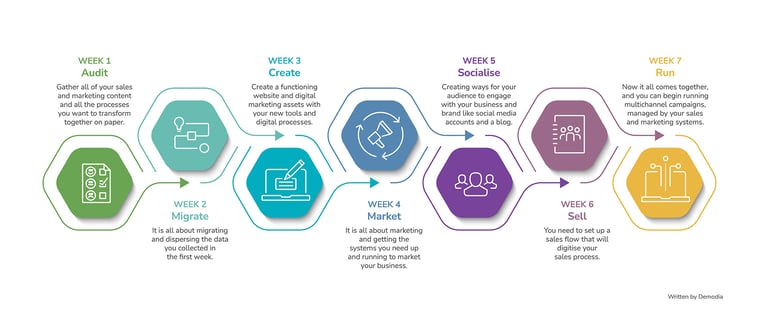
Significant changes need big plans - but you need to lay the groundwork first.
Plotting out how your company will go about digitally transforming its processes requires a thought-out, thorough approach. However, transforming too much of your processes at once can cause massive disruptions and chaos. This is where a digital transformation roadmap comes in handy.
Digital transformation offers benefits that could revolutionise the way your company runs. Already, 56% of CEOs say digital improvements have led to increased revenue, while many B2B companies have reported a 10% to 20% cost reduction and revenue growth of 10% to 15% from transforming their customer experience processes. However, digital transformation that promotes these benefits for the long-term need to have a solid plan of action in place, and companies need to prepare the groundwork before implementing the changes they want.
In this blog post, we'll outline both preparing your company for digital transformation and the planning that goes into such an initiative.
Preparing your business for digital transformation
In a previous blog post, "6 benefits and 6 examples of digital transformation", we covered some of the more theoretical considerations for digital transformation. These considerations would lead you to more practical applications, which we will discuss now.
Getting company-wide buy-in
Once you understand the value you will get from digital transformation, you will need to convince the rest of your company. Mckinsey reports that approximately 70% of digital transformations fail, most often due to resistance from employees. We recommend focusing on the benefits and savings digital transformation offers while assuring your team that it can be done without sacrificing anyone's position.
First, start with a clear reason why that explains the business needs that will be addressed and the challenges that will be overcome. With this "why statement", you should also provide a value proposition to explain the business and employees' ongoing benefits from the transformation. Lastly, you should enable your team to provide feedback and give them a chance to be involved in the process. They should feel free to pose questions, offer suggestions or simply ask about their new tasks and roles.
Competitor and market research

Before you decide on an application to help you through your business's digital transformation, it may help to take a look at what your competitors are doing. It's likely that your immediate competitors are attempting to achieve something similar or already have digital processes in place to optimise their businesses. Please pay special attention to competitors who have already succeeded in digital transformation, as they will most likely have the most to offer in terms of direction for your own company.
In addition to competitor research, you should also examine your overall market to understand the current trends for your industry. You can use this to compare your approach or as a means of inspiration to add to your digital transformation.
Creating a budget
Digital transformation can range from inexpensive solutions to extremely costly overhauls, depending on the scope of your transformation. Once you understand the purpose of the change and have identified what tools you need, it's time to create a budget.
Your budget should include all the expenses you expect to encounter throughout the digital transformation process. This includes application costs, development costs, transitional tools, new hires, employee training and a few extra funds for any unforeseen expenses.
Remember to keep in mind that even tools which fulfil similar functions may not be suited for your business in its current stage of development. For example, you may need very basic marketing automation for a small company, not HubSpot's enterprise-level plan. Thus, it's essential to match your needs with the digital solutions on offer.
Create a digital transformation plan
With your strategy firmly in place, you can finally begin to create a digital transformation roadmap to help take your company through the process. This part is a little more detailed and will have to be customised to your own specific needs.
Thus, in the next section, we will provide a template for you to use to map out your digital transformation journey.
Building a digital transformation roadmap
Plotting out how your company will go about digitally transforming its processes requires a thought-out, thorough approach. However, transforming too much of your processes at once can cause massive disruptions and chaos. This is where a digital transformation roadmap comes in handy.
With a digital transformation roadmap, you can space out each step of your approach and structure the transformation in a way that causes the least amount of disruption. Below you can find explanations of the sections included in the plan laid out for a complete digital transformation.

 WEEK 1 - Audit
WEEK 1 - Audit
The first week of your digital transformation should include gathering all of your sales and marketing content and all the processes you want to transform together on paper. Single out any of these that can be re-used for the transformation. During this first week, you should pay special attention to items that worked well for the company in the past to integrate them with your new approach.
 WEEK 2 - Migrate
WEEK 2 - Migrate
Week two is all about migrating and dispersing the data you collected in the first week. This time, you'll list your business on online directories like Google Business and get all of your contacts and content into your new systems such as marketing automation, Customer Relationship Management (CRM) platforms, content repositories and other databases.
 WEEK 3 - Create
WEEK 3 - Create
You should create a functioning website and digital marketing assets during week three with your new tools and digital processes. The website should include keywords, a form for capturing leads and contact information, while your new marketing assets must embrace your new approach to digital marketing. It would be best to use this time to ensure that your website reporting and analytics are up and running and all the content you saved before is ready to be used.
 WEEK 4 - Market
WEEK 4 - Market
Week four is all about marketing and getting the systems you need up and running to market your business. This would usually take the form of marketing automation and email marketing initiatives. Using the insights from the tools in week 3, you can create highly personalised and relevant communications with your customers.
 WEEK 5 - Socialise
WEEK 5 - Socialise
The fifth week of your digital transformation will involve creating ways for your audience to engage with your business and brand. In addition to creating and linking up social media accounts, you can use this time to set up a blog to engage with your audience. Be sure to constantly link back to your website and use the keywords you identified in week three to boost your search engine ranking where you can.
 WEEK 6 - Sell
WEEK 6 - Sell
By the end of week six, you should have set up a sales flow that will digitise your sales process. This means setting up a system that keeps track of all your contacts, logs your conversations and keeps tabs on where your customers are in the sales pipeline.
 WEEK 7 - Run
WEEK 7 - Run
Week seven is where it all comes together, and you can begin running multichannel campaigns that feed into your website, managed by your sales and marketing systems. You can segment your contacts to engage with specific leads on specific subjects, begin paid advertising on social media, launch PPC campaigns and content marketing. Whatever new approach to running your business, your new digitally transformed company will be able to take it and amplify its success.
Putting it all together
The above is just a short outline of how a company would generally approach digital transformation. To ensure the smoothest transition, you need an expert to guide you through the multiple aspects of digital transformation, like selecting the right tools, identifying evolution opportunities and training your team.
Here at Demodia, we use 3 simple steps to help you digitally transform your business for the best results possible:
- Book your consultation - This is a free meeting to review your current tools, systems and goals.
- Build your digital tool set - We explain the process and guide you through the tools you'll use. We also support you and help train you to do it yourself.
- Grow your business - Watch the new business roll in through the right tools and applications.
Contact us today, and let us guide you to accomplishing more for your organisation through digital transformation.



